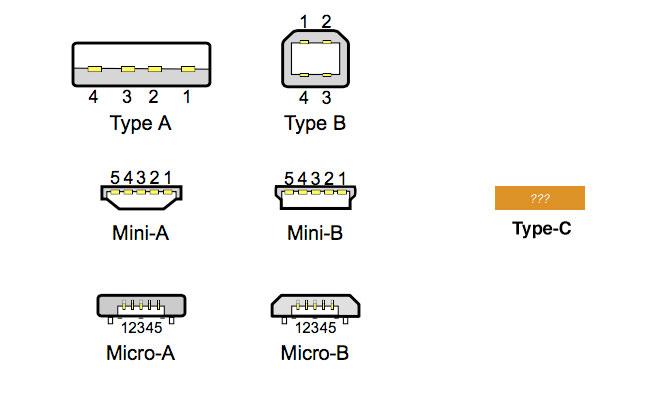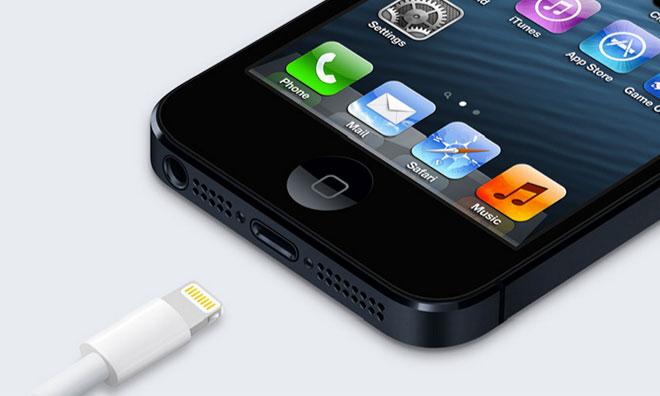The USB Implementers Forum on Wednesday announced that the USB 3.1 specification will bring with it a new style of connector that can be plugged in in any orientation and will support future USB technologies like USB Power Delivery, high-speed data transfer, and video-over-USB.
The Type-C connector's design is not known, but it will be similar in size to the Micro-B. Source: Wikipedia
The plug will sport an entirely new design that is similar in size to the existing Micro-B connector and will work with USB 3.1, USB 3.0, and USB 2, according to the USB-IF. The Micro-B connector — Â which is used by Apple as a service port on the Apple TV — Â measures just 6.85 millimeters by 1.80 millimeters.
Much to the relief of users who have been frustrated with existing USB connectors' unidirectional nature, the USB-IF will take a page from Apple's playbook and make the Type-C reversible. Apple's reversible Lightning connector, which replaced the venerable 30-pin dock connector beginning with the iPhone 5, has been lauded by users for its ease-of-use and allowed Cupertino to save precious space in devices thanks to Lightning's compact 7.7 millimeter by 1.7 millimeter dimensions.
USB's inventor, Intel engineer Ajay Bhatt, told The Economist in October that making the connector "flippable" was his next goal. USB has, according to the publication, been saddled until now with one-way plugs due to a desire to keep manufacturing costs as low as possible.
Flying under the radar in the USB-IF's announcement was the revelation that the Type-C connector will support USB 3.1's USB Power Delivery feature. USB PD is designed to deliver up to 5 amps and 100 watts to connected devices, significantly expanding the range of items that can be powered by the port. USB 3.0, in contrast, provides just 1.5 amps and 10 watts.
USB PD also allows for devices to negotiate for power. For instance, a laptop running on battery power can increase charging capacity to a connected handset when the laptop is idle, then reduce the capacity when it needs to spin up its hard disk.
USB PD can provide power for a range of devices from handsets to desktop computers.
USB PD is not limited to small electronics. Moixa, a London-based technology company, powers its office's LED lighting, monitors, printers, and laptops from a prototype USB PD implementation.
Combining USB 3.1's anticipated 10 Gbps throughput and the USB PD system makes the standard a staunch competitor to Apple and Intel's Thunderbolt interface. Though Thunderbolt 2 bumped throughput to 20 Gbps, a Thunderbolt cable can provide just 10 watts of power to connected devices, and the connector — Â though small — Â is still nearly twice as large as the proposed USB Type-C plug.
The USB-IF has showed off the combination's potential at this year's CES with an impressive demonstration, discovered by AnandTech, that mimicked Thunderbolt's ability to drive daisy-chained displays while transferring data with the added twist of powering the devices entirely via USB PD.
Two monitors, one connected to mains power, and a Lenovo laptop were modified to work with USB 3.0 and the USB PD standard. The mains-connected monitor was able to power both the laptop and the other monitor, allow the laptop to use both monitors as external displays, and enable the laptop to access a thumb drive connected at the end of the chain with just a single USB cable.
Nearly every device in Apple's product line makes use of USB in some way, and with USB 3.1 presenting a meaningful challenge to Thunderbolt, it is unclear what path Cupertino will take in the future. Ports represent one of the most limiting constraints in device design — Â the USB port, for instance, is the MacBook Air's thickest port, coming in at nearly the same height as the laptop's display.
Apple has a history of striving to eliminate as many ports from its devices as possible. In the service of scale, DVI has given way to Mini DVI and eventually to Mini DisplayPort. Mini DisplayPort and Firewire, in turn, gave way to Thunderbolt. Dual microphone and headset ports were consolidated into a single port in the MacBook Air.
Even Apple's relatively new and low-profile MagSafe power connectors have been redesigned to be thinner, with the MagSafe 2 debuting in the Retina MacBook Pro.
With the USB 3.1 specification not expected to be finalized until mid-2014, the possibility exists that Apple and Intel may make enhancements to Thunderbolt to compete with USB 3.1 and USB PD before the new standard can achieve market ubiquity. Thunderbolt was originally conceived to use optical connections for data transfer, and some have theorized that the companies could design a hybrid optical-electrical cable that would both boost throughput and allow for increased power delivery.
 Shane Cole
Shane Cole








-m.jpg)






 Marko Zivkovic
Marko Zivkovic
 Christine McKee
Christine McKee
 Andrew Orr
Andrew Orr
 Andrew O'Hara
Andrew O'Hara
 William Gallagher
William Gallagher

 Mike Wuerthele
Mike Wuerthele
 Bon Adamson
Bon Adamson




-m.jpg)



69 Comments
When will this USB3.1 be available?
USB has been so ubiquitous because of price. It is cheap and good enough. What they are talking about doesn't seem so cheap anymore. 5A current carrying capacity means larger cabling, which means added cost. The circuitry for managing the power distribution will add complexity to the controller chip. While it isn't a given, there is also the possibility that the reversible nature of the plug might require some sort of active logic chip such as that used in the Lighting port. If this turns out to be true then this again will add cost. Not to mention that adding the ability to daisy-chain means added complexity and/or ports. And none of this even addresses the issue of latency/priority that has always been one of the biggest drawbacks of USB when compared to Firewire and Thunderbolt. Honestly, I have never understood the whole drive to cast USB and Firewire/Thunderbolt as competitors. Yes, they are both connection ports, but they were never really meant to serve the same market. All this being said, I hope that the new USB can deliver all of these promises for the price that has made USB so popular. It would be great for consumers, but at this time I am going to be cautiously optimistic.
Maybe they'll use a TRS design only with more sections for more wires.
silly title. I think it's less a
I don't think Apple's sales will be 'challenged' by the introduction of a flippable USB cable. In fact it will align with Apple's keep it simple cabling mode (something that they've been doing since the NeXT, where all cables inserted with the label side up).
And I don't see USB designers going 'Dammit Jim, We're losing the connection war... We got to make our plugs flippable! or Apple will take over the Galaxy!"
If anything, this is Apple designing more smarts into the receptacle logic, making human life just a bit simpler, and the world goes... Hey, for $2.00 more in manufacturing costs, we can do this to USB too!
And for the over 40 crowd... remember when SCSI connectors were the size of harmonica?
USB: the least universal port ever devised, now in its ninth redesign, eventually to have eleven.
Just kill it already.